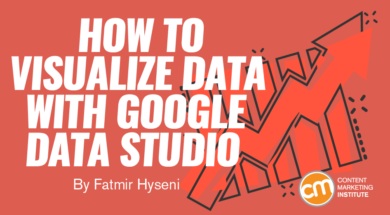82% of marketers struggle to identify and report analytics data. Are you one of those who simply want to interpret your analytics visually?
Have you ever heard of Google Data Studio?
In this article, I’ll show you how to transform your data into engaging and interactive visual reports with Google Data Studio via the Content Marketing Institute. What do you think? What are your thoughts on Google Data Studio? Please leave your comments below.
You’re familiar with Google Docs and Sheets, but have you used Google Data Studio? The free tool lets you turn data into eye-catching visuals and easy-to-read reports.
Whether you’re reaching executives reviewing analytics (82% of CMOs say they lack the experience to effectively do it) or you’re telling number-based stories to your website visitors, visualization can be a compelling and dynamic format.
Data Studio also is user friendly – you don’t need to write code or know what SQL (structured query language) is. With pre-built data connectors, Data Studio handles all data authentications and access rights to use for calculations, transformations, and data visualizations. It also can convert raw data into the metrics needed for easy-to-follow reports and dashboards.
And, like other tools in the Google family, you can create content in a community – editing and managing comments, dashboards, and reports within and outside of your company.
It is truly drag-and-drop technology, offering the ability to customize charts, graphs, colors, shapes, images, and logos.
HANDPICKED RELATED CONTENT: Rant Alert: Content Marketers Must Up Their Data Game
Consider purpose and formats
Before you log into Data Studio, think about what data you want illustrated. Do you want to analyze your website metrics? Display multiple data points on the same chart to tell a longitudinal story? Create a graph to illustrate concepts? Develop a standardized report for your team?
At the same time, you also need to identify what data is available and where it can be accessed. Data Studio lets you choose data from a single source or multiple points. It accommodates a variety of data products (Google and non-Google), including:
- Google Marketing Platform products such as Ads, Analytics, Display & Video 360, and Search Ads 360
- Google Sheets, YouTube, and Google Search Console
- Databases like Big Query, MySQL, Campaign Manager and PostgreSQL
- Individual files in formats like comma separated value (CSV)
- Social media such as Facebook, Reddit, and Twitter
Begin to consider the format options for sharing that data:
- Line, bar, or pie charts
- Geographic mapping
- Area and bubble graphs
- Paginated data or pivot tables
- Interactive reports with filters and data-range controls
- Content catalogs or libraries with built-in hyperlinks and clickable images
- Annotations for your reports
At this point, you just need to narrow your format options; the final decision can come later.
TIP: To learn more about Google Analytics and Data Studio, check out this YouTube video from those Google teams.
Now that you have the foundation of what you want to achieve with Data Studio, it’s time to create the visualization. Let’s walk through the steps of creating an original report.

